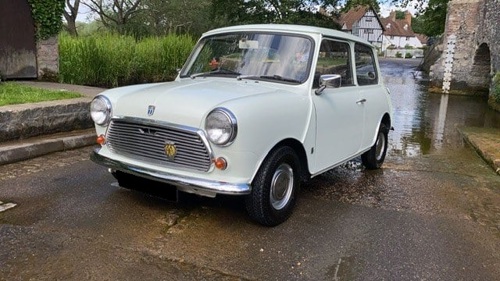DO YOU REMEMBER THE MINI 850
23 December 2024
Watching old television programmes can give a very distorted view of the 1970s. Not everyone is dressed in the latest Kings Road fashions, not all men had the wardrobe and hairstyle of Roger Moore in The Persauders! - and not everyone drove a Mini Clubman, let alone the 1275GT. Even the 1000 was beyond many budgets, for the norm was the 850, and this 1972 model sold by GC Minis is a rare example of the third-generation Mini au naturelle.

The British Leyland Motor Corporation introduced the Mini Series III in late 1969, and many aspects would have amazed the owner of a 1959 bottom-of-the-range model. For one, it even had a heater and windscreen washers as standard. At the same time, the front doors’ winding windows were possibly the ultimate luxury. The fascia even lacked the BMC “Flashing Indicator Stalk”, as the warning lamp was now incorporated in the speedometer.
However, many of the 850’s details were familiar to previous Mini owners, from the central dial incorporating the fuel gauge to the ‘magic wand’ gear lever. Nor were there any distractions, such as dashboard air vents, as that was the province of the Clubman. As for a water temperature gauge, a passenger sun visor and a “fresh air heater”, you needed to spend another £88 on the Mini 1000.
But it was the Mini 850 that dominated British roads in the 1970s, as police Panda cars, entry-level company cars or young motorist’s first new car. As Keith Adams puts it in www.aronline.co.uk:
1971 turned out to be the peak year of production with 318,475 Minis leaving British Leyland’s worldwide production lines. 258,427 emerged from Longbridge and 60,048 from overseas plants. BLMC’s total vehicle production for that year was 1,062,742, the Mini’s contribution was nearly 30% of that figure.
By 1971 “the Mini in terms of volume became the dominant car at Longbridge”. British Leyland proclaimed it their best-selling car in Europe by October of the following year. Lord Stokes, the Corporation’s Chair, believed ‘No one can improve on its styling. I think it is a dateless car that will go on for many years yet.’ The 1972 London Motor Show marked BL’s celebration of Mini production exceeding three a million units.
At that time, the 850 cost £663 compared with £642 for the basic Hillman Imp, £478 for the Fiat 500L (which, with the best will in the world, was not a four-seater) or £798 for the Reliant Rebel 700. Those needing more doors could opt for the Citroën Dyane 4 at £637 or spend £675 on a Renault 4, but the Mini remained the ideal town car.
As the brochure stated: “the compact Mini is a lot of fun to drive”.
With thanks to GC Minis for their time and permission to use the images in this blog.
